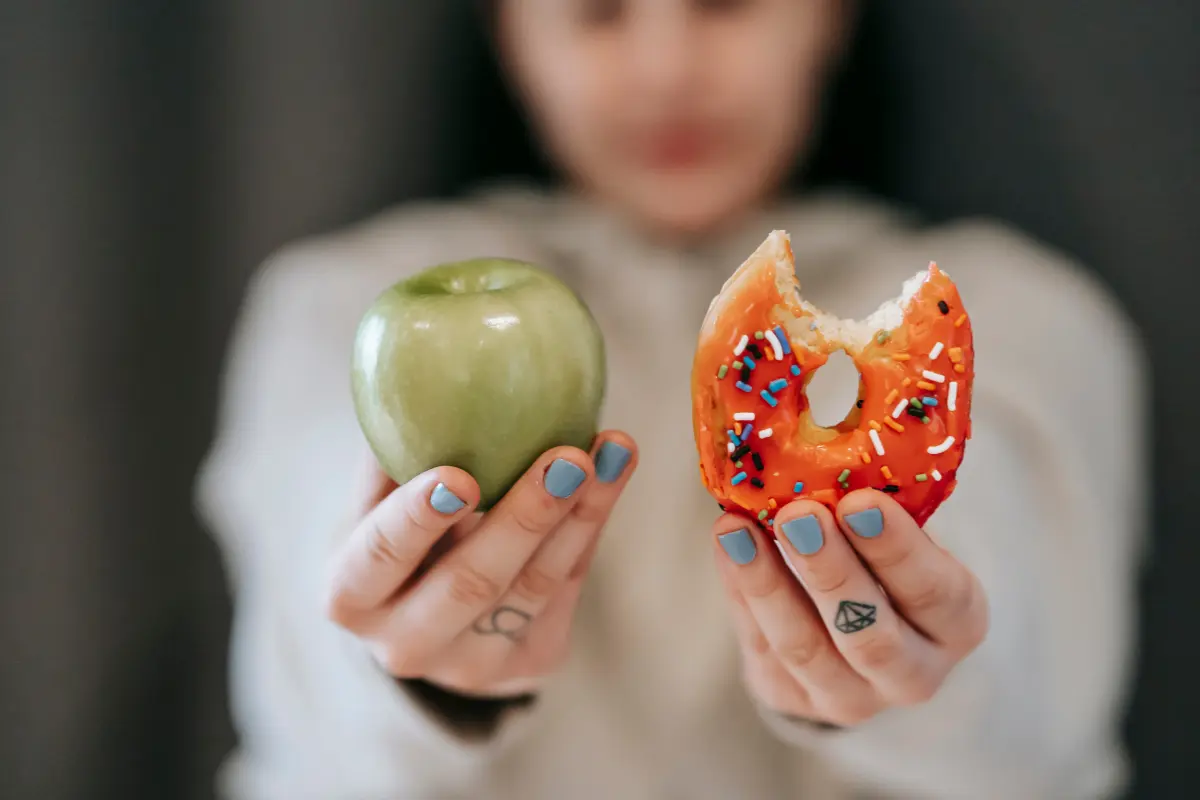
You just finished a meal, and you still feel hungry. Or you might have gone through all macros and still feel your stomach rumbling at the end of the day. What should you eat? Should you eat at all?
“Should I eat if I’m still hungry?”
Let's explore the answer to this very relevant and common question.
Unlearning Undereating
You're not alone if you’re sold on the idea that undereating is the fastest way to lose weight.
While this may sometimes be the case, eating less isn’t always the magic answer you may think it is—and it certainly isn’t the rule.
Advertisement
When you sign up for a 1:1 WAG Nutrition Coach, you may be shocked by how much your coach recommends you eat, especially if you are trying to lose weight or body fat. When I assign macros to a client, I can often tell that there are alarm bells in their head.
Years and years of popular (but not always helpful or healthy) myths and opinions about nutrition, body weight, and weight loss trigger these alarm bells. The bottom line is that you are not alone if you have weight loss goals and feel confused about how much you should eat to help you get there.
Thoughts like these are prevalent:
- “Wow, this seems like a lot of food for a fat loss goal. I thought I was supposed to starve myself!”
- “How will eating more really help me lose weight?”
- “I am scared to trust the process. What happens if I start gaining a ton of weight?”
- "This goes against everything I have ever heard.”
Psychology refers to the discomfort you feel when confronted with contradictory information to a long-held belief as “cognitive dissonance” [1].
It can be difficult to “unlearn” something you thought to be true… add the emotion that comes around nutrition, body image, and self-esteem, and you have a recipe for some profound cognitive dissonance on your hands.
Advertisement
That is OK! Learning a bit of the science behind why undereating can stall progress will help build trust with your hunger cues and feel more relaxed with the concept of eating more to see the results you want.
Can Undereating Stall Weight Loss?
Here are some of the reasons why undereating can stall weight loss progress:
Hormonal Imbalances. This can lead to water retention, increased stress, unwanted fat storage, shifts in the menstrual cycle, and more [1]. Chat with your primary care physician, OBGYN, or another health professional if you believe you are dealing with hormonal imbalances. Specific suggestions to support healthy hormones are outside of most nutrition coaches’ scope of practice. But, a coach can help you put medical advice into practice and build habits around your doctor’s recommendations.
Decreased Energy Levels. You’re less likely to feel energized during workouts or performing daily tasks. That reduced energy, in turn, leads to less calorie expenditure during the day, which is the opposite of what you want.
Decreased Metabolism. When you undereat, your body burns fewer calories throughout the day—both because it digests less food and because your body naturally starts to down-regulate the energy it expends to conserve as much as possible.
Advertisement
Understanding Hunger Signals
When you undereat for an extended period of time, your hunger signals may not be trustworthy. Sending hunger signals requires energy, so if you have been chronically dieting and ignoring those signals for a long time, your body may stop sending those signals to conserve as much energy as possible. You’ll need to “relearn” how to listen to what your body is telling you.
If you are overeating some days and undereating on others, it is essential to try and identify the pattern. Large fluctuations in daily caloric intake can make learning what works best for your body challenging. Consistency is key!
Think of it like a science experiment—A valid conclusion comes from an experiment repeated multiple times under the same circumstances. If you keep changing the “input” (macros, activity levels, routine), you cannot reliably measure the “output” (your results). Overall, consistency serves you best.
How a Coach Can Help
If someone told you, “eat more, trust me!” it would be tough to buy, right? Even if you did, you probably would hesitate to fully commit with so much mainstream media telling you that eating less is the ticket to weight loss.
One of the BIG things we believe in at WAG Nutrition is being open and honest. Our coaches explain why they make macro decisions and ask you what you think, feel, and feel comfortable with so you are included in the decision-making process.
Advertisement
It is essential for you, as a client, to be open and honest about any doubts or concerns you have. Then, you and your coach can work together to build up to an intake that you are both comfortable with.
Should I Eat if I'm Not Hungry?
This can be tricky to answer because listening to your body is essential to building a healthy relationship with food. So an answer from your coach like, “Yes! Ignore that you feel full and keep eating,” may not feel quite right, which is more than understandable.
There are some unique instances when you may need to eat, even if your stomach feels pretty full.
- If you’re working with a doctor and they’ve suggested that you need to increase calories to improve overall health. (This is especially important for women. Here’s why!).
- If you have muscle and strength gain goals.
- If you compete in a weight-specific sport and need to increase your weight to fit into your desired weight class.
- If you have weight loss goals, you’re already eating at a very low-calorie intake, and your coach suggests a reverse diet to ensure your metabolism is well-supported.
If you fall into one of these categories, it doesn’t mean you have to feel full and uncomfortable 24/7. Let’s talk about some tips for dealing with low hunger so you can fuel your body adequately and feel confident in your skin.
Tips for Dealing with Low Hunger
Incorporating a few of these go-to tips into your day will make things more seamless as you transition to a higher caloric intake.
Advertisement
-
- Opt for denser macro sources, aka “low-volume” food. Emphasize foods denser in macros so you can eat a lower volume of food for the same (or more) calories. For example, if you still have extra carb macros to eat at dinner, adding some rice and veggies can help take up more macros without making you feel stuffed. Adding a scoop of nut butter to a smoothie or seeds on a salad can help bump calorie intake without adding volume to your meals.
- Make high-calorie food swaps. If you’ve been dieting for a while, you may be in the habit of always opting for high-volume options like cauliflower rice, zucchini noodles, and huge salads. Although these things are healthy and chock-full of vitamins and minerals, picking and choosing places to swap those high-volume foods for their higher-calorie counterparts will help. Try real rice or whole wheat noodles.
- Try a healthy protein bar. Because they’re smaller and take up less room in your stomach, you can get in more calories without feeling as full.
- Pre-plan macros. If you find yourself super busy throughout the day and forget to eat, pre-planning can help you stay focused. You can plan to space out your macros throughout the day and avoid feeling like you have to overeat at night.
- Monitor hunger levels and eat when you are most hungry. Your hunger levels vary at different times of the day. Take a week to identify those times. Once you have nailed down those times, take advantage of them and plan to eat more during those times.
- Experiment with meal size and timing. Some people prefer to eat smaller meals more frequently throughout the day, and others feel more balanced with larger, less frequent meals. It all comes down to what feels the best for you.
- Slowly increase the amount of food over time. This article talks about reversing dieting or slowly increasing your food over time!
- Increase sleep quality. Research shows that lack of sleep and low-quality sleep can decrease activity in the area of the brain responsible for hunger cues and affect the hormones involving appetite regulation [2,3]. Sleep is a non-negotiable that can play a significant role in many health areas.
- Drink some macros. Adding macros in liquid form is an easy way to consume more calories. Blend veggies and fruits into a smoothie, swap water for milk in your protein shake, or add protein powder or collagen powder to your morning coffee. Coconut water, kombucha, electrolyte drinks, and sports drinks can help you get in some extra calories without feeling super full.
Eating more to lose weight is a balancing act of mindfulness and deliberate planning.
Attention = Awareness = Choice
You’ll learn so much by listening and being in tune with your hunger levels while trying some of the strategies above to ensure you are well-fueled every day.
Overall, hesitancy to eat more is a common struggle. But do not let it stop you! Put in the work, stay deliberate with your effort, explore new concepts and ideas, and get the support of a 1:1 nutrition coach. Then, you’ll have everything you need to achieve your goals!
References:
- Hollins-Martin, C. J., Akker, O. B., Martin, C. R., & Preedy, V. R. (2014). Handbook of diet and nutrition in the menstrual cycle, periconception and fertility. Wageningen Academic.
- Cherry, K. (2020). What is cognitive dissonance? Very Well Mind. Retrieved from https://www.verywellmind.com/what-is-cognitive-dissonance-2795012
- Greer, S., Goldstein, A., & Walker, M. (2013). The impact of sleep deprivation on food desire in the human brain. Nature Communications, 4(2259). doi:10.1038/ncomms3259
- Taheri, S., Lin, L., Austin, D., Young, T., & Mignot, E. (2004). Short sleep duration is associated with reduced leptin, elevated ghrelin, and increased body mass index. PLoS Med, 1(3). doi:10.1371/journal.pmed.0010062
Schedule a Free Intro Call
Working Against Gravity has led the macro tracking and health space for over a decade. Our team doesn’t just understand the science of nutrition—we’ve spent years mastering the art of tailoring it to fit your life. That means no cookie-cutter plans, just real strategies that have worked for over 30,000 people.
Schedule a free call with our team to learn how working with a 1-on-1 WAG coach will help you reach your goals.



